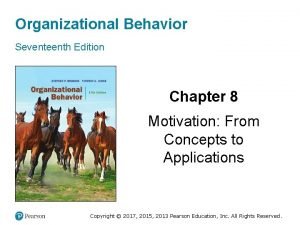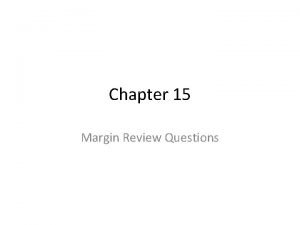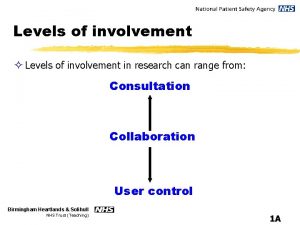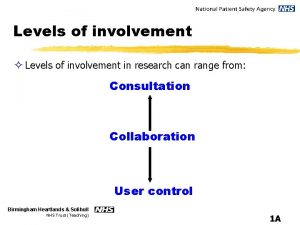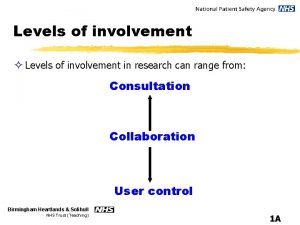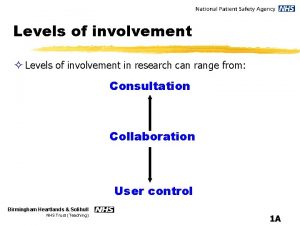Levels of involvement Levels of involvement in research
















- Slides: 16

Levels of involvement ² Levels of involvement in research can range from: Consultation Collaboration User control Birmingham Heartlands & Solihull NHS Trust (Teaching) 1 A

What is evaluation? ² Evaluation is work to explore “the value, merit, worth or significance of the thing in question” ² We evaluate all the time ² We evaluate research to see if: ¶the aims of the research have been fulfilled ¶they have been done well ¶it helps tell us more about a specific issue ¶the results are accurate ¶the results suggest a change in practice/services Birmingham Heartlands & Solihull NHS Trust (Teaching) 1 B

Systematic Reviewer ² Identifies a health condition or treatment that needs to be reviewed ² Brings a team together of health and social care professionals and users and carers with a knowledge of the condition ² Searches for studies (published and unpublished) ² Carries out the review - assesses the design, brings the information together and analyses the data ² Publishes the review so that many people can read it ² An example of this type of systematic reviewer is the Cochrane Collaboration Birmingham Heartlands & Solihull NHS Trust (Teaching) 1 C

Peer Reviewing Systematic Reviews ² Does the review need to be done? ² Does the review use appropriate language for the public and healthcare professionals? ² Are the team the most appropriate to do it? ² Does it consider all people? ² Are the outcomes important to users and carers? ² Has the reviewer considered potential harm as well as benefits? Birmingham Heartlands & Solihull NHS Trust (Teaching) 1 D

To produce clinical guidelines ² Can be done locally or nationally ² Identifies a health condition or treatment that needs a clinical guideline to help clinicians ² Brings a team of health and social service professionals and users and carers together who have knowledge of the condition or its treatment ² Searches for studies (published and unpublished) ² Reviews the research and make recommendations ² Publishes guidelines on the recommended care Birmingham Heartlands & Solihull NHS Trust (Teaching) 1 E

Opportunities for user involvement in evaluating research ² There are potentially many areas where users can become involved with evaluating research – you could be a: ¶Member of the Cochrane Collaboration Systematic Review Group ¶Member of the Cochrane Collaboration Review Group ¶Member of the NICE Clinical Guidelines Group ¶Member of a local trust Clinical Guidelines Group Birmingham Heartlands & Solihull NHS Trust (Teaching) 1 F

Why is user involvement in evaluating research important? ² User involvement in evaluating research and development is important because consumers: ¶Offer a ‘reality check’ ¶Bring an ‘antidote to jargon and pomposity’ ¶Help make reviews relevant to and readable for everyone, not just healthcare professionals ¶Raise new questions and topics that are relevant to users and carers Birmingham Heartlands & Solihull NHS Trust (Teaching) 1 G

Example: The Cochrane Collaboration Peer Reviewer ²Purpose of doing peer review: ¶Assess systematic reviews to ensure the systematic review is: w appropriate w unbiased w carried out thoroughly w has considered user perspective Birmingham Heartlands & Solihull NHS Trust (Teaching) 2 A

Example: The Cochrane Collaboration Peer Reviewer ²How users get involved: ¶Identify that a review has not already been carried out in an area that interests them or they think is important ¶Nominate to join the peer review panel ¶Attend training in peer reviewing Birmingham Heartlands & Solihull NHS Trust (Teaching) 2 B

Example: The Cochrane Collaboration Peer Reviewer ²Support provided to user consultants: ¶Online training resources to teach users in peer reviewing (Open College) ¶Join the Cochrane Consumer Network ¶‘Buddy system’ – this is where you buddy up with another reviewer (user, carer or health and social service staff member) and can talk with them about what you are doing Birmingham Heartlands & Solihull NHS Trust (Teaching) 2 C

Example: The Cochrane Collaboration Peer Reviewer ²Level of influence or decision-making: This is similar to that of a health or social service staff member who is a peer reviewer ¶Full member of the review team ¶Partners in the review process ¶Give guidance on the user perspective Birmingham Heartlands & Solihull NHS Trust (Teaching) 2 D

Example: The Cochrane Collaboration Peer Reviewer ² Activities that happen: The team: ¶Assesses the plan of the review ¶Identifies and negotiates review tasks that members carry out ¶Assesses the complete review for: w language w relevance and importance to users w potential benefits and harm ¶Develops a final version Birmingham Heartlands & Solihull NHS Trust (Teaching) 2 E

Example: The Cochrane Collaboration Peer Reviewer ²Strategies for success: ¶online training and support for users (buddy system for mentoring and debriefing) ¶equal partnership between users and professionals ¶providing an opportunity to comment on research evidence which is usually only made available to professionals Birmingham Heartlands & Solihull NHS Trust (Teaching) 2 F

Example: The Cochrane Collaboration Peer Reviewer ² Problems that could occur: ¶insufficient knowledge of the research process to enable to users’ voices to be heard ¶insufficient knowledge of user involvement by the professionals ¶insufficient numbers of users represented on the group ¶insufficient support and mentoring for users and carers so they can participate as fully as possible Birmingham Heartlands & Solihull NHS Trust (Teaching) 2 G

Thinking about practical issues – what does it mean for you? 1. Number of user consultants involved 2. Costs of involvement 3. What is the user consultant role description? 4. Being prepared for the role 5. At what stage are user consultants involved? 6. Office space or equipment 7. Number of methods for gaining user involvement used Birmingham Heartlands & Solihull NHS Trust (Teaching) 3 A

Thinking about practical issues – what does it mean for you? 8. How much information you receive 9. Handling confidential information 10. Training 11. Mentoring 12. Your connection to a network of other users, carers, the public 13. Debriefing opportunities or support 14. Opportunity to reflect on what you learn 15. Dealing with personal difficulties Birmingham Heartlands & Solihull NHS Trust (Teaching) 3 B
 3 levels of costa's questions
3 levels of costa's questions Youth involvement
Youth involvement Personal ministry goals
Personal ministry goals Panther involvement network
Panther involvement network What are the 7 principles of social work?
What are the 7 principles of social work? Panther involvement network
Panther involvement network Gsu pin events
Gsu pin events How can employee involvement measures motivate employees
How can employee involvement measures motivate employees Gaisce silver record sheet
Gaisce silver record sheet Tunnel preparation in dentistry
Tunnel preparation in dentistry Brazil ww2 involvement
Brazil ww2 involvement Active community participation definition
Active community participation definition What drove european involvement in asian commerce
What drove european involvement in asian commerce Father involvement in early childhood
Father involvement in early childhood Theory of social judgement (sherif) menyatakan bahwa
Theory of social judgement (sherif) menyatakan bahwa Joyce epstein model
Joyce epstein model Class 2 furcation
Class 2 furcation







